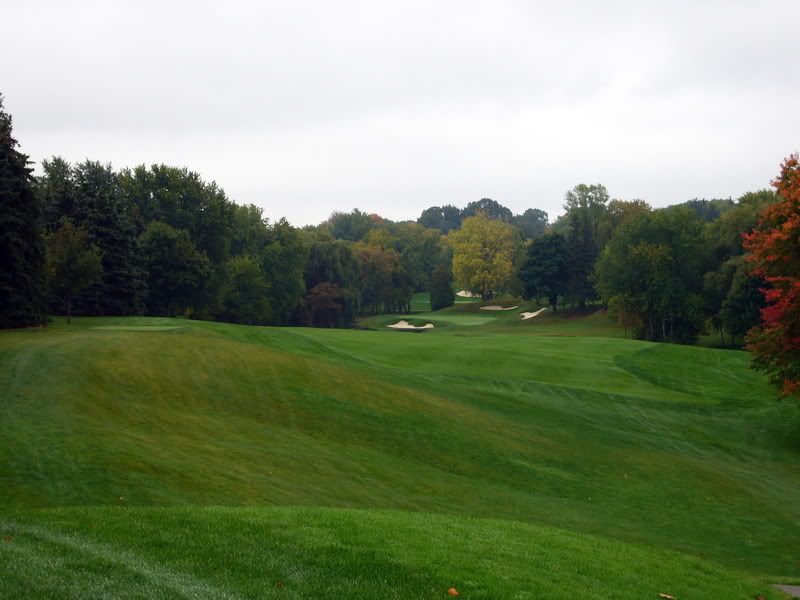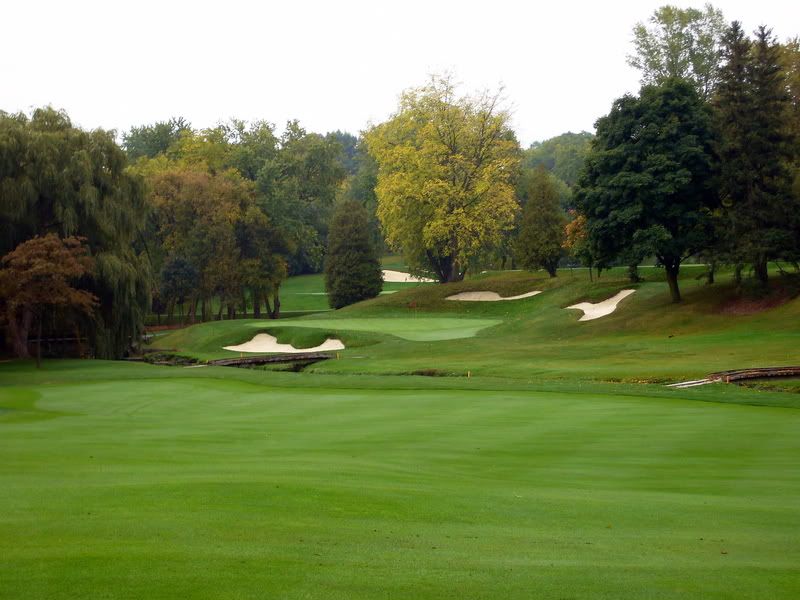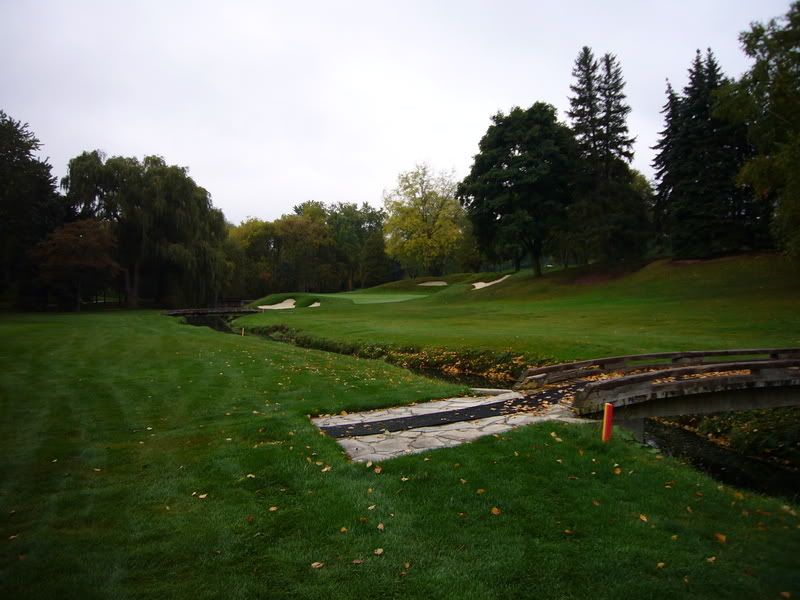All I could find were two "course-level" threads (not specific to 14) by I. Andrew discussing his 2003-04 restoration work of the course. (With original photos apparently no longer available.

)
What's the right play off the tee?
I think the strategy off the tee is to hit it as far right as you're comfortable. The green opens up from the right side and the risk to carry the stream reduces. But too far right and you risk hitting into the stream or trees, or into gnarly rough that will complicate your second shot.
There's another risk to going right, too: as is the defining characteristic of of this excellent Stanley Thompson course, a slope threatens to catch your ball, giving an awkward stance for your next shot, or perhaps even worse kick your tee shot too far right and into the rough. As the yardage book below indicates, if you've chosen the right tee your tee shot will carry just to or over the precipice, raising all kinds of risks associated with getting hung up or kicking rightward.
The safer (flatter) route off the tee is left, then, but I have to think this is the less than ideal approach: you have to carry the stream and a bunker to a green that is wide from this angle but not deep. Going long carries its own perils, too, so you can't just blow it over stream and bunker with impunity.
But I'm using "think" throughout this commentary because the approach shot is no bargain from either side. Although the green does open up from the right, it presents a Cape Hole type of challenge: the green looks pretty skinny wedged in there between the stream and bunker on the left and a bunker plus the slope on the right! Kinda like a Scylla and Charybdis deal then...
Further confusion came after reading the 1930 comments of some guy named B.L. Anderson of the Royal Canadian Golf Association: "The green is barely visible from the tee and requires a carefully placed tee shot along the boundary line on the left." (Re "barely visible:" the hole has been lengthened, and I assume moving back the tees meant locating them on higher ground.)
Which reminds me, shooting down the left is no risk-free thing, either, as Oscar Bravo lurks over there.
So I think you want to play it down the right but make sure your landing area over there isn't going to kick your ball over into the rough. I think.
1. How would you play this hole?
2. The bunker front-left of the green -- the one lodged between the green and the stream -- is not a Thompson original. Would you remove it, and if so, how would you choose maintain the grass on that slope? Would removing the bunker make the hole harder for low handicaps, high handicaps, both, or neither? Would removal change the risk-reward for approaches from the left? What about from the right? Would removal tilt the balance so that the golfer always sought to approach from one side or another?
3. What are other good examples of streams being used in concert with green complexes to create angles? The ones that come immediately to my mind are 17 Royal New Kent and MacKenzie's version of 16 ANGC. (I guess technically that would be
nee 7 ANGC.)
Here's the yardage-book entry for the hole -- not sure it's really representative. For example, the tees I think are farther left than appear in this schematic. Nevertheless, it does provide yardages:
 Google aerial -- trust me, it ain't this flat!
Google aerial -- trust me, it ain't this flat! Tee shot: "basin and range" pretty typical of this course -- note ridgeline is jusst where your tee shot will carry:
Tee shot: "basin and range" pretty typical of this course -- note ridgeline is jusst where your tee shot will carry: Approach from center of fairway: seems to me left is not the way to go...
Approach from center of fairway: seems to me left is not the way to go... View of green showing perspective of golfer approaching from right side: green opens up, but stream runs all the way down -- neither a hooker nor a slicer be!
View of green showing perspective of golfer approaching from right side: green opens up, but stream runs all the way down -- neither a hooker nor a slicer be!
Thanks
Mark
KeywordsStanley Thompson
Par 4s
Streams
Lateral Hazards
Risk and Reward
Option-Laden
St. George's
Toronto